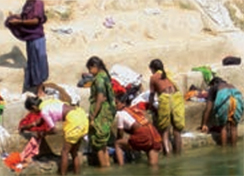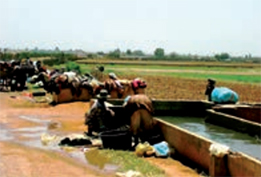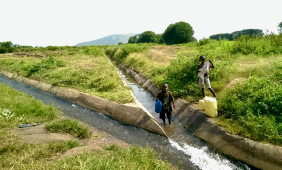Building Water Access for One Health: Multiple Water Use Systems, Water Stations, Air-to-Water NonConventional Technologies
Enhancing Access to Clean Water

COVID-19 reinforces the need for access to clean water for health, and food and nutrition security. Reliable Water, Sanitation and Hygiene (WASH) facilities are essential to containing the spread of the virus. However, approximately 2.2 billion people lack access to safely managed drinking water services and 4.2 billion people lack safely managed sanitation services affecting people’s health and access to safely produced food worldwide. Currently more than 820 million people globally do not have enough food to eat and often access to financing for safe water and sanitation is limited.
Access to clean water and sanitation is necessary and it is at the heart of SDG6 Water and Sanitation. Smart and digital technologies can be helpful and essential to saving lives. Enhancing access to water system at large either multiple water systems or point of use (POU) handwashing stations along with WASH kits can make water more available. Taking into account the importance to accelerate access to clean water, the use of nonconventional water (NCW) resources could be beneficial for water and sanitation when made available where innovative technologies such as air to water may have essential functions.
Technology Solutions: Multiple Use Systems and Point of Use Facilities and Access to Micro-Credits
- Use of digital technologies and baseline land and water resources information can help accelerating response plans by identifying vulnerable food value-chains including market locations and critical areas and design tailor-made and prioritised interventions that can enhance access to WASH in urban, peri-urban and rural areas.
- Water stations have several advantages when appropriate filtering systems are in place. These units provide access to clean water sources. They must be introduced with adequate sanitation and hygiene equipment (e.g. soap and/or alcohol) and recommendations on hand hygiene against the transmission of COVID-19. See the World Health Organization’s twelve step hand washing process. https://www.who.int/gpsc/clean_hands_protection/en/;
- A barrier to safe water and sanitation is often access to affordable financing. Micro-credit can help enable access to affordable financing and provide technical support to make access to clean water a reality. Micro-financing solutions demonstrate that access to resources can help women get more access to productive resources, which would be unavailable to them otherwise.

- Air-to-Water Technology (above) draws air into the generator where the air filter traps particles and dust for water to condensate through heat exchange and cooling process. The water condensate goes through another filter to get rid of water impurities to produce clean water fit for drinking and handwashing in time of COVID-19.
- Accelerating action to address access to water, can also come from the use of nonconventional water technologies. The One Water approach is based on the premise that all forms of water (rainwater, groundwater, surface water, brackish water, used water, fit-for-purpose reuse water) are linked and form a system that provides the most effective service when managed in an integrated fashion. Some of these are: Reclaimed Water; Cloud Seeding; Water-from-air device; Rainwater Harvesting; Desalination.
- Multiple Use Systems - Combining SMART-Irrigation with SMART-WASH
Multiple Use Systems

Multiple uses of water involve the practice of using water from the same source or infrastructure for multiple uses and functions. The importance of multiple use systems (MUS) for water is increasingly growing, but with different approaches and levels of scale based on the context, resource allocation and sectoral backgrounds. Different scales refer to the well-distinguished levels of household, water system and river basin that require distinct planning approaches. Resource allocation can be defined as natural boundaries of land and water resources that can be managed under development of multiple watersystems. Finally, sectoral background is identified as the current development stage, potential and need of considered sectors such as irrigation, water and sanitation, livestock etc. Exploiting the opportunities is of paramount importance in order to make water use consistent with efficiency, productivity and sustainability objectives. The potential of multiple water systems is particularly high in irrigation sector, where the overall efficiency of irrigation systems is estimated at 60 per cent, meaning that somewhat 40 per cent of the supplied water does not reach the lands and is lost through evaporation, runoff and deep percolation. By allowing water use for different purposes in the same time, the realized gain of “value per drop” can be significantly amplified.

While multiple water use is an opportunity to increase water efficiency, productivity and reduce water scarcity, its promotion is particularly timely in the light of the spreading COVID-19. Provision of access to safe water is the prerequisite to slow down pandemic spread. On the other side, the inherited impacts of COVID-19 measures on food security requires urgent development of food production systems. Irrigation plays inevitable role to make agriculture more productive, thus increasing food supply to meet demand. It is, therefore, clearer than ever before that any future water resource development should comply with the requirement of extended need of water for sanitation and hygiene. Water saving through multiple water use has spill-over effect on sanitation making more resources available for the sectors. In order to effectively respond to the pandemic-induced crisis, Land and Water Division introduces the initiative of SMART Irrigation – SMART WASH (WAter, Sanitation, and Hygiene). This twin-track approach proposes corporate solutions to enhance irrigation and provide WASH facilities to vulnerable communities.
Benefits of multiple water system at different scales

- At the time of COVID-19 outbreak around 2.4 billion people mostly in Sub-Saharan Africa and other developing countries lacked access to improved sanitation and hygiene facilities involving water (UNU, 2017). Frequent handwash with soap for 20 seconds is widely recommended by WHO to stop the spread of this disease, this activity could add an additional burden of 58 million m3/day using the recommended protocol of hand washing i.e. 12 times a day (or 24 lit/capita). This enormous challenge can only be overcome by promoting and facilitating multiple water system. For instance, in Ben Nafa Kacha, Burkina Faso, FAO constructed water ponds to promote multiple water use in order to prevent people to use directly the irrigation canal for domestic purposes.
- Multiple water systems not only directly benefit the users in terms of improved health and hygiene by slowing down the spread of COVID-19, it could also generate the much-needed financial resources in the post lockdowns slow economies caused by this pandemic. In that case, the regions where enough water is available could legalise the trade-offs between multiple water uses to generate extra income. For example, the Fenh irrigation district in China (FAO, 2010, Zhang, Guo, 2016) has a potential to allocate more than 300 million m3 of water per year for multiple uses among the irrigation, hydropower plant, coal power plants, steel factories and other aesthetic uses. The transfer of this raw water to the given secondary and tertiary industry has a potential to earn an estimated incremental benefit of 2 billion USD/year.
Country cases:
- Mapping Systems and Services for Multiple Uses, Kirindi Oya Irrigation Settlement Project Sri Lanka, A MASSMUS Application, http://www.fao.org/3/a-ap502e.pdf
- An average 660 kg/ha standing stock of fish biomass can be produced in the minor canals of Gezira irrigation system. http://www.fao.org/3/ca2675en/CA2675EN.pdf
- Between 2005-2011, there were 12 071 conflicts in Burkina Faso between farmers and herders over land and water resources. https://unowas.unmissions.org/sites/
default/files/rapport_pastoralisme_eng-april_2019_-_online.pdf
For more info please contact:

